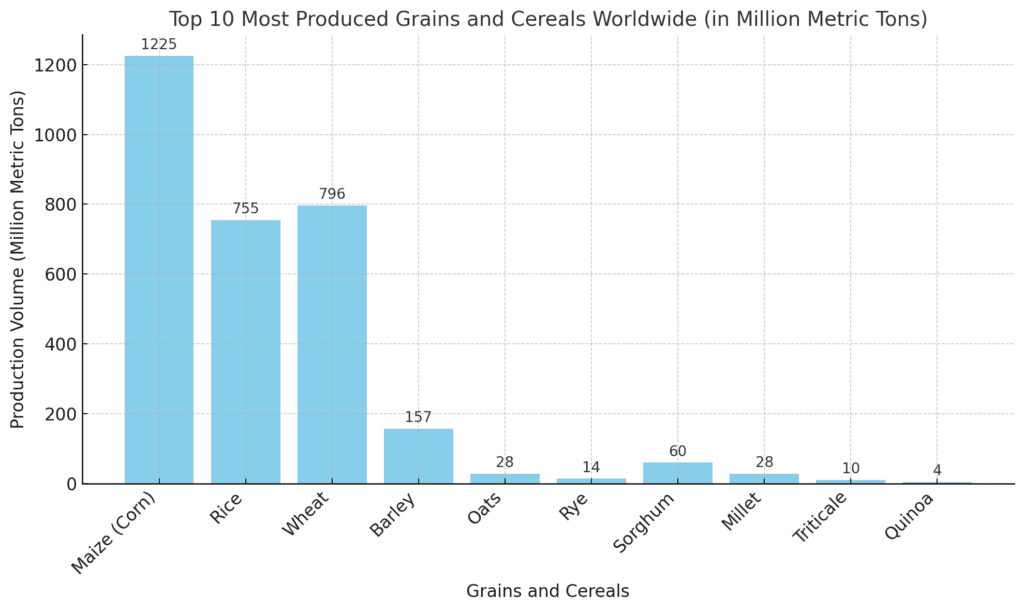Introduction
Grains and cereals are essential food sources for billions of people around the world. From providing key nutrients to supporting livestock feed and industry, they play a critical role in global agriculture. In this report, we’ll take a look at the top 10 most produced grains and cereals worldwide, based on production volumes and market share.

1. Maize (Corn) – The Global Leader
Production Volume: 1.225 billion metric tons
Maize is the most produced cereal globally. This versatile grain is used for human consumption, animal feed, and industrial purposes like biofuel production. It holds the highest production volume due to its adaptability to various climates and its high yield per hectare.
Market Share: 43% of global cereal production.
2. Rice – The Staple Crop for Asia
Production Volume: 755 million metric tons
Rice is the staple food for more than half of the world’s population, particularly in Asia. It is a crucial crop in countries such as China, India, and Indonesia, where it serves as the primary source of calories for billions.
Market Share: 26% of global cereal production.
3. Wheat – A Global Breadbasket
Production Volume: 796 million metric tons
Wheat is the third most produced cereal, grown primarily in temperate regions like North America, Europe, and Russia. It is the primary ingredient for bread, pasta, and other staple foods in many parts of the world.
Market Share: 28% of global cereal production.
4. Barley – A Versatile Grain
Production Volume: 157 million metric tons
Barley is widely grown in cooler regions and is used for both food and livestock feed. It is also a key ingredient in beer production and animal feed. Barley production is concentrated in countries like Russia, Canada, and the European Union.
Market Share: 5.5% of global cereal production.
5. Oats – A Popular Breakfast Cereal
Production Volume: 28 million metric tons
Oats are commonly consumed as breakfast cereal and are known for their health benefits. They are also used in livestock feed and in the production of oat-based products like milk alternatives and snacks. The leading producers of oats are Russia, Canada, and the United States.
Market Share: 1% of global cereal production.
6. Rye – A Hardy Cereal
Production Volume: 14 million metric tons
Rye is primarily grown in cooler climates and is used in the production of bread, particularly in Northern and Eastern Europe. It is also used in animal feed and as a rotation crop for soil health.
Market Share: 0.5% of global cereal production.
7. Sorghum – A Drought-Resistant Grain
Production Volume: 60 million metric tons
Sorghum is a drought-tolerant cereal grown mainly in Africa, India, and parts of the United States. It is used for food, animal feed, and biofuel production. It is also a staple in some parts of Africa and Asia.
Market Share: 2% of global cereal production.
8. Millet – A Nutritious Ancient Grain
Production Volume: 28 million metric tons
Millet is a highly nutritious grain grown in arid regions of Asia and Africa. It is an important food source in countries like India and Nigeria, offering a gluten-free alternative to wheat.
Market Share: 1% of global cereal production.
9. Triticale – A Hybrid Grain
Production Volume: 10 million metric tons
Triticale is a hybrid grain developed by crossing wheat and rye. It is mainly used as livestock feed and in the production of various food products. It is grown primarily in Europe and parts of North America.
Market Share: 0.4% of global cereal production.
10. Quinoa – The Ancient Grain with Modern Appeal
Production Volume: 4 million metric tons
Quinoa, originally from the Andes, has gained popularity globally as a high-protein, gluten-free alternative to other grains. While its production remains relatively small, it has seen rapid growth in markets like North America and Europe.
Market Share: 0.1% of global cereal production.
Global Market Trends
These top 10 cereals account for the majority of global cereal production, with maize, rice, and wheat leading the charge. Here are a few key trends affecting the global cereal market:
- Climate Change: Variations in weather conditions can lead to fluctuating yields, particularly for crops like wheat and maize, which are sensitive to droughts and extreme temperatures.
- Technology: Innovations such as genetically modified (GM) crops and precision farming techniques are helping boost yields and increase resilience to climate change.
- Changing Consumption Patterns: With the rise of gluten-free and health-conscious diets, cereals like quinoa and millet are seeing increasing demand, especially in Western markets.
Conclusion
The global cereal market is dominated by maize, rice, and wheat, which together account for the majority of production. Other cereals like barley, oats, and sorghum play important roles in both food and feed markets. Understanding the production volumes and market share of these top 10 grains is essential for businesses and policymakers navigating the food industry.